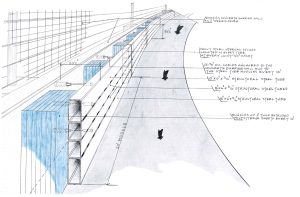On February 18, 2001, Dale Earnhardt Sr. tragically passed away due to a basilar skull fracture at the age of 49 during a crash that happened on the last lap of the 43rd Daytona 500. Inducted into the Nascar Hall of Fame’s inaugural class in 2010, Dale Earnhardt Sr. was considered one of the greatest drivers in NASCAR history, racing from 1975 until his tragic death in 2001. Earnhardt Sr. was known as “The Intimidator” and “Ironhead” for his aggressive driving style. Throughout the years, the barrier to keep the racing vehicles on the racetrack was made of concrete walls that were placed around the exterior and interior of the track. With these, NASCAR safety engineers found that there were serious injuries and fatalities that occurred upon impact with these rigid barriers.
There needed to be a solution, so in 2002, they installed the SAFER barrier at the Indianapolis Motor Speedway. The Steel and Foam Energy Reduction Barrier, also known as a SAFER barrier, is a high-strength, tubular steel skin that distributes the impact load to energy-absorbing foam cartridges in order to reduce the impact and provide protection to those who are racing. When the organization saw the success of the initial barrier installation at the Indianapolis Motor Speedway, they began to install SAFER barriers at every racecourse utilized by NASCAR and INDYCAR to lessen the chance of injury and vehicle damage. While it hasn’t had the opportunity to reach every racetrack, it is likely that all 29 NASCAR tracks will be installing these safety systems to prevent what happened on the tragic day that caused the death of Dale Earnhardt Sr.
The SAFER barrier consists of 3/16th inch thick steel tubings that are backed with thick, closed-cell foam blocks that are retrofitted to the existing cement walls of a racetrack. Though easier said than done, the installation of the SAFER barrier takes two to three months at each track. To install the SAFER barrier, tracks need to order the materials and bend the steel tubings to perfectly fit each unique track, and it takes a two to three-week process to get the tubings installed.
During the development process of the SAFER barrier, the creator, Midwest Roadside Safety Facility, University of Nebraska-Lincoln, won several awards and accolades. These awards ranged from things such as the 2004 Inaugural Pioneering and Innovation Award to multiple awards of excellence including the SEMA Motorsports Engineering Award. The barrier first became patented in 2005, with an update to the patent in 2008.
Though the SAFER track isn’t on every NASCAR race track just yet, NASCAR has made great strides to ensure safety for their drivers and pit crew. The NASCAR organization wants to ensure a more safe, but more entertaining and fun environment for the drivers, their families, and their fans. The SAFER barrier allows those involved in the races to have peace of mind that everyone will be safe and those will be able to make it home safely to their family and loved ones.
Are you interested in selling Verizon Wireless services? Call us at (855) SELL-VZW or fill out the form below. We look forward to speaking with you soon!


